Tourism-Induced Land Use Transformations, Urbanisation, and Habitat Degradation in the Phu Quoc Special Economic Zone
Abstract
1. Introduction
2. Materials and Methods
2.1. Study Area
2.2. Landsat Satellite Images and Processing
2.3. Land Use, Land Cover Classification
2.4. Assessment of Land Use and Land Cover Changes and Urban Expansion
2.5. Land Surface Temperature Retrieval and Analysis
2.6. Habitat Quality Modelling
2.7. Analysis of Driving Forces Behind Habitat and Thermal Environment Changes
3. Results
3.1. Land Use and Land Cover Changes
3.2. Urban Expansion
3.3. Habitat Quality Degradation
3.4. Changes in Thermal Environment
3.5. Key Drivers of Habitat Quality and Thermal Environment Changes
4. Discussions
4.1. Characteristics of LULCCs and Urban Expansion in Island City
4.2. Environmental Degradation and Implications
4.3. Broader Implications for LULCCs in Island SEZs
4.4. Future Directions
5. Conclusions and Outlook
Author Contributions
Funding
Data Availability Statement
Acknowledgments
Conflicts of Interest
Appendix A
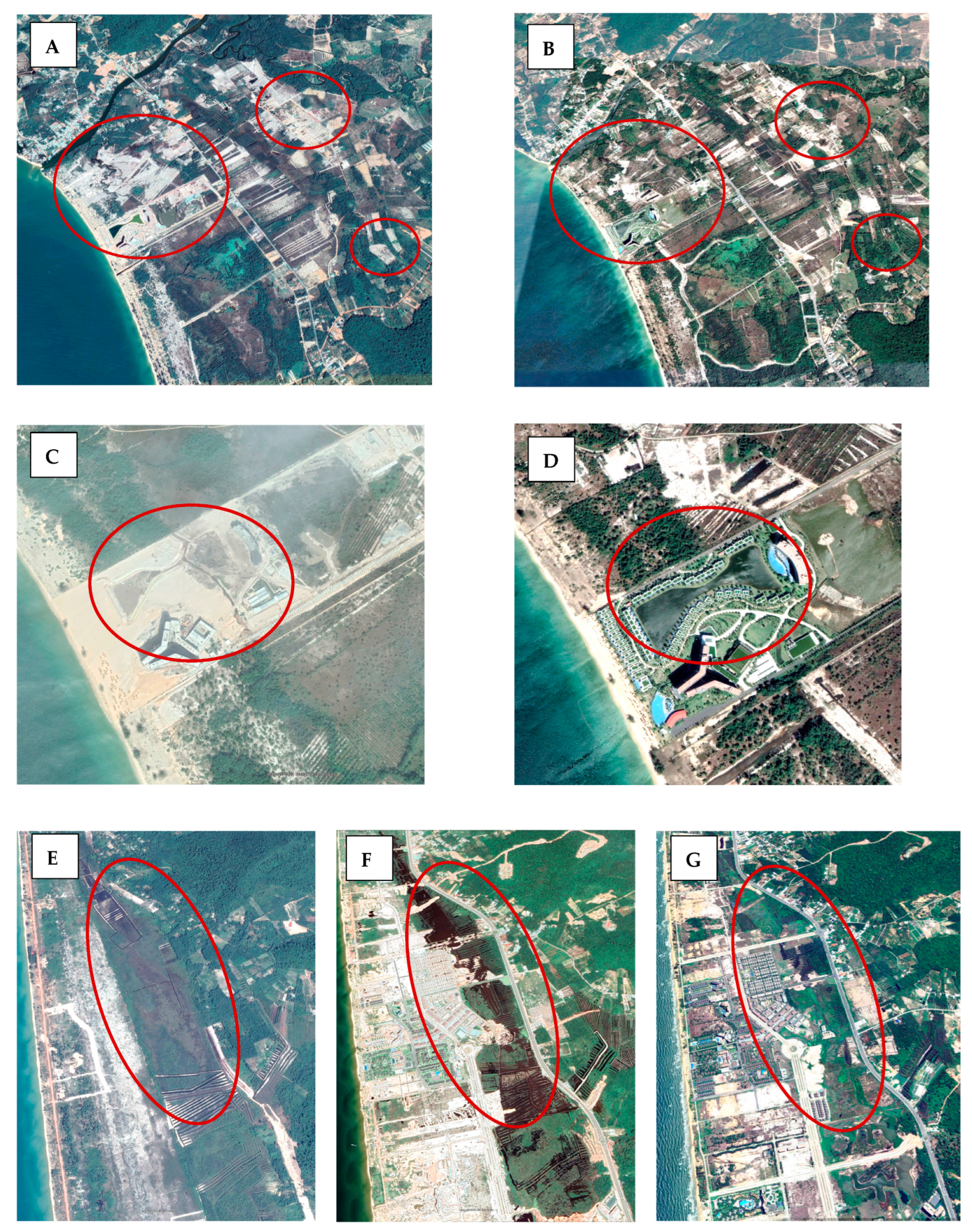
References
- Su, S.; Xiao, R.; Jiang, Z.; Zhang, Y. Characterizing Landscape Pattern and Ecosystem Service Value Changes for Urbanization Impacts at an Eco-Regional Scale. Appl. Geogr. 2012, 34, 295–305. [Google Scholar] [CrossRef]
- Follmann, A.; Kennedy, L.; Pfeffer, K.; Wu, F. Peri-Urban Transformation in the Global South: A Comparative Socio-Spatial Analytics Approach. Reg. Stud. 2023, 57, 447–461. [Google Scholar] [CrossRef]
- Tang, K. The Political Economy of Special Economic Zones: The Cases of Ethiopia and Vietnam. Rev. Int. Polit. Econ. 2023, 30, 1957–1983. [Google Scholar] [CrossRef]
- Nguyen, C.T.; Ton-That, L.; Pham, T.D. Land Use, Land Cover Changes and Expansion of Artificial Reservoirs in Eastern Thailand: Implications for Agriculture and Vegetation Drought Reduction. Environ. Monit. Assess. 2024, 196, 1009. [Google Scholar] [CrossRef]
- Weggel, O. Vietnam’s Policy of Economic Zoning. J. Curr. Southeast Asian Aff. 2007, 26, 79–98. [Google Scholar]
- Nguyen, H.Q.; Tien, D.N. Special Economic Zones and FDI Attraction to Districts in Vietnam: A Non-Parametric Approach. Singap. Econ. Rev. 2021, 66, 1027–1053. [Google Scholar] [CrossRef]
- Zappa, M. “Greening” Speculative Urbanism? Space Politics and Model Circulation in South Korea and Vietnam’s Special Economic Zones. Nuovi Aut. Democr. Dirit. Ist. Soc. 2022, 4, 68–86. [Google Scholar] [CrossRef]
- Nguyen, C.T.; Kaewthongrach, R.; Channumsin, S.; Chongcheawchamnan, M.; Phan, T.N.; Niammuad, D. A Regional Assessment of Ecological Environment Quality in Thailand Special Economic Zone: Spatial Heterogeneous Influences and Future Prediction. Land Degrad. Dev. 2023, 34, 5770–5787. [Google Scholar] [CrossRef]
- Hoa, P.N.; Khai, T.Q. Establishing Three Special Zones in Vietnam: Opportunities and Challenges for Socio-Economic Development. Soc. Sci. Inf. Rev. 2018, 12, 12–20. [Google Scholar]
- Hong, N.; Kim, S. Beyond Desakota: The Urbanization Process and Spatial Restructuring in Contemporary Vietnam. Urban Res. Pract. 2023, 16, 582–604. [Google Scholar] [CrossRef]
- Fan, P.; Ouyang, Z.; Nguyen, D.D.; Nguyen, T.T.H.; Park, H.; Chen, J. Urbanization, Economic Development, Environmental and Social Changes in Transitional Economies: Vietnam after Doimoi. Landsc. Urban Plan. 2019, 187, 145–155. [Google Scholar] [CrossRef]
- Hieu, V.; Vu, N.; Nwachukwu, C. Exploring Human Resources, Marketing and Promotion Activities towards the Sustainable Tourism Development in Phu Quoc Islands, Vietnam. Management 2020, 24, 39–55. [Google Scholar] [CrossRef]
- Quyet, L.V.; Duy, P.T.; Toan, V.P. Sustainable Development of Tourism Economy in Phu Quoc Island, Kien Giang Province, Vietnam: Current Situation and Prospects. IOP Conf. Ser. Earth Environ. Sci. 2022, 1028, 012005. [Google Scholar] [CrossRef]
- Ngan, N.T.K. Resolution No. 1109/NQ-UBTVQH14: Establishment of Phu Quoc City and Wards of Phu Quoc City, Kien Giang Province, Ha Noi, 2020; The Standing Committee of the National Assembly: Hanoi, Vietnam, 2020. [Google Scholar]
- Ha, T.H. Decision No. 150/QĐ-TTg: Decision Approving the Master Plan of Phu Quoc City, Kien Giang Province to 2040, Ha Noi, 2024; Prime Minister: Hanoi, Vietnam, 2024. [Google Scholar]
- Government News Phu Quoc Transforms to Become Top Growth Pole of Kien Giang. Available online: https://en.baochinhphu.vn/phu-quoc-transforms-to-become-top-growth-pole-of-kien-giang-111240331204729209.htm (accessed on 18 October 2024).
- Thao, N.D.L. Attracting Investments for the Development of Smart City Phu Quoc–Kien Giang Province. Int. J. Adv. Econ. 2022, 4, 63–77. [Google Scholar] [CrossRef]
- Sanchez-Ortiz, K.; Gonzalez, R.E.; de Palma, A.; Newbold, T.; Hill, S.L.L.; Tylianakis, J.M.; Börger, L.; Lysenko, I.; Purvis, A. Land-Use and Related Pressures Have Reduced Biotic Integrity More on Islands than on Mainlands. bioRxiv 2019. [Google Scholar] [CrossRef]
- Li, G.; Yang, X.; Liu, Q.; Zheng, F. Destination Island Effects: A Theoretical Framework for the Environmental Impact Assessment of Human Tourism Activities. Tour. Manag. Perspect. 2014, 10, 11–18. [Google Scholar] [CrossRef]
- Matias, T.P.; Leonel, J.; Imperador, A.M. A Systemic Environmental Impact Assessment on Tourism in Island and Coastal Ecosystems. Environ. Dev. 2022, 44, 100765. [Google Scholar] [CrossRef]
- Storch, H.; Downes, N.; Rujner, H. A Scenario-Based Approach to Assessing the Exposure and Flood Risk of Ho Chi Minh City’s Urban Development Strategy in Times of Climate Change. In The EnviroInfo 2011: Innovations in Sharing Environmental Observation and Information, Proceedings of the 25th International Conference on Informatics for Environmental Protection, Ispra, Italy, 5–7 September 2011; Shaker Verlag: Maastricht, Germany; Herzogenrath, Germany; pp. 270–279.
- Dao, M.T. Assessing the Vulnerability of Phu Quoc Island’s Natural and Socio-Economic Systems to Climate Change. IOP Conf. Ser. Earth Environ. Sci. 2024, 1395, 012037. [Google Scholar] [CrossRef]
- Tan, K.C.; Lim, H.S.; MatJafri, M.Z.; Abdullah, K. Landsat Data to Evaluate Urban Expansion and Determine Land Use/Land Cover Changes in Penang Island, Malaysia. Environ. Earth Sci. 2010, 60, 1509–1521. [Google Scholar] [CrossRef]
- Aljenaid, S.S.; Kadhem, G.R.; AlKhuzaei, M.F.; Alam, J.B. Detecting and Assessing the Spatio-Temporal Land Use Land Cover Changes of Bahrain Island During 1986–2020 Using Remote Sensing and GIS. Earth Syst. Environ. 2022, 6, 787–802. [Google Scholar] [CrossRef]
- Newase, S.; Acharjee, M.R.; Talukder, A.; Nishi, S.Q. Temporal Evolution of Land Use-Land Cover Changes, Focusing on Present Mariculture Sites along the Moheshkhali Island, Bangladesh. GeoJournal 2024, 89, 54. [Google Scholar] [CrossRef]
- Gowthaman, R.; Dwarakish, G.S.; Sanilkumar, V. Land Use/Land Cover Changes around Rameshwaram Island, East Coast of India. Indian J. Geo-Mar. Sci. 2014, 43, 1183–1186. [Google Scholar]
- Jenkins, R.; Kennedy, L.; Mukhopadhyay, P.; Pradhan, K.C. Special Economic Zones in India: Interrogating the Nexus of Land, Development and Urbanization. Environ. Urban. ASIA 2015, 6, 1–17. [Google Scholar] [CrossRef]
- Zeng, D.Z. The Past, Present, and Future of Special Economic Zones and Their Impact. J. Int. Econ. Law 2021, 24, 259–275. [Google Scholar] [CrossRef]
- Xu, J.; Wang, X. Reversing Uncontrolled and Unprofitable Urban Expansion in Africa through Special Economic Zones: An Evaluation of Ethiopian and Zambian Cases. Sustainability 2020, 12, 9246. [Google Scholar] [CrossRef]
- de Wit, J. Land Governance of Suburban Areas of Vietnam: Dynamics and Contestations of Planning, Housing and the Environment. ISS Work. Pap. Ser. 2013, 561, 1–37. [Google Scholar]
- Miatto, A.; Dawson, D.; Nguyen, P.D.; Kanaoka, K.S.; Tanikawa, H. The Urbanisation-Environment Conflict: Insights from Material Stock and Productivity of Transport Infrastructure in Hanoi, Vietnam. J. Environ. Manag. 2021, 294, 113007. [Google Scholar] [CrossRef] [PubMed]
- Thinh, N.K.; Kamalipour, H. Mapping Informal/Formal Morphologies over Time: Exploring Urban Transformations in Vietnam. Cities 2024, 152, 105168. [Google Scholar] [CrossRef]
- Mohammadyari, F.; Zarandian, A.; Mirsanjari, M.M.; Suziedelyte Visockiene, J.; Tumeliene, E. Modelling Impact of Urban Expansion on Ecosystem Services: A Scenario-Based Approach in a Mixed Natural/Urbanised Landscape. Land 2023, 12, 291. [Google Scholar] [CrossRef]
- Wang, J.; Zhou, W.; Pickett, S.T.A.; Yu, W.; Li, W. A Multiscale Analysis of Urbanization Effects on Ecosystem Services Supply in an Urban Megaregion. Sci. Total Environ. 2019, 662, 824–833. [Google Scholar] [CrossRef] [PubMed]
- Nguyen, D.T.H.; Tripathi, N.K.; Gallardo, W.G.; Tipdecho, T. Coastal and Marine Ecological Changes and Fish Cage Culture Development in Phu Quoc, Vietnam (2001 to 2011). Geocarto Int. 2014, 29, 486–506. [Google Scholar] [CrossRef]
- Tin, H.C.; Uyen, N.T.; Tu, N.H.C.; Binh, N.H.; Ni, T.N.K. Dynamics of Seagrass Beds and Land Use–Land Cover Characteristics in Vietnamese Marine Protected Areas. Reg. Stud. Mar. Sci. 2023, 59, 102794. [Google Scholar] [CrossRef]
- Nang, L.N.; Hieu, P.T.; Phat, L.V.; Tien, P.M.; Man, H.N.T.; Hang, H.T. Characteristics of Newly Discovered Amber From Phu Quoc, Vietnam. Gems Gemol. 2022, 58, 184–194. [Google Scholar] [CrossRef]
- Minh, H.V.T.; van Ty, T.; Nam, N.D.G.; Lien, B.T.B.; Thanh, N.T.; Cong, N.P.; Meraj, G.; Kumar, P.; van Thinh, L.; van Duy, D.; et al. Modelling and Predicting Annual Rainfall over the Vietnamese Mekong Delta (VMD) Using SARIMA. Discov. Geosci. 2024, 2, 19. [Google Scholar] [CrossRef]
- Phong, N.T.; van Tien, H. Water Resource Management and Island Tourism Development: Insights from Phu Quoc, Kien Giang, Vietnam. Environ. Dev. Sustain. 2021, 23, 17835–17856. [Google Scholar] [CrossRef]
- Huan, V.D.; Ngoc, P.T.B. Evaluation of Site Selections for Solid Waste Landfill by Using GIS in Phu Quoc Island, Kien Giang Province, Vietnam. IOP Conf. Ser. Earth Environ. Sci. 2023, 1247, 012015. [Google Scholar] [CrossRef]
- Thien, B.B.; Kuznetsov, A.N.; Phuong, V.T. Monitoring Land Use/Land Cover Change Using Remote Sensing and GIS Techniques in Phu Quoc Island, Kien Giang Province, Vietnam. Nexo Sci. J. 2024, 37, 83–98. [Google Scholar] [CrossRef]
- Pham, V.P.Q.; Thirumaran, K. Managing Development of Resort Destinations in Southeast Asia: Emerging and Peripheral Phu Quoc Island. In Development of Tourism and the Hospitality Industry in Southeast Asia; Mandal, J.V.P., Ed.; Springer: Singapore, 2016; pp. 83–95. [Google Scholar]
- Wulder, M.A.; Loveland, T.R.; Roy, D.P.; Crawford, C.J.; Masek, J.G.; Woodcock, C.E.; Allen, R.G.; Anderson, M.C.; Belward, A.S.; Cohen, W.B.; et al. Current Status of Landsat Program, Science, and Applications. Remote Sens. Environ. 2019, 225, 127–147. [Google Scholar] [CrossRef]
- Zhang, Y.; Ai, Y.; Su, F.; Su, H.; He, Z.; Wang, C.; Ying, J.; Zhou, M. A Comparative Analysis of Different Terrain Correction Methods Based on Landsat-8 OLI Data. IOP Conf. Ser. Earth Environ. Sci. 2021, 671, 012003. [Google Scholar] [CrossRef]
- Talukdar, S.; Singha, P.; Mahato, S.; Pal, S.; Liou, Y.-A.; Rahman, A. Land-Use Land-Cover Classification by Machine Learning Classifiers for Satellite Observations—A Review. Remote Sens. 2020, 12, 1135. [Google Scholar] [CrossRef]
- Teffera, Z.L.; Li, J.; Debsu, T.M.; Menegesha, B.Y. Assessing Land Use and Land Cover Dynamics Using Composites of Spectral Indices and Principal Component Analysis: A Case Study in Middle Awash Subbasin, Ethiopia. Appl. Geogr. 2018, 96, 109–129. [Google Scholar] [CrossRef]
- Tucker, C.J. Red and Photographic Infrared Linear Combinations for Monitoring Vegetation. Remote Sens. Environ. 1979, 8, 127–150. [Google Scholar] [CrossRef]
- Can, T.N.; Chidthaisong, A.; Diem, P.K.; Huo, L.Z. A Modified Bare Soil Index to Identify Bare Land Features during Agricultural Fallow-Period in Southeast Asia Using Landsat 8. Land 2021, 10, 231. [Google Scholar] [CrossRef]
- Qi, J.; Chehbouni, A.; Huete, A.R.; Kerr, Y.H.; Sorooshian, S. A Modified Soil Adjusted Vegetation Index. Remote Sens. Environ. 1994, 48, 119–126. [Google Scholar] [CrossRef]
- Gao, X.; Huete, A.R.; Ni, W.; Miura, T. Optical-Biophysical Relationships of Vegetation Spectra without Background Contamination. Remote Sens. Environ. 2000, 74, 609–620. [Google Scholar] [CrossRef]
- Jin, S.; Sader, S.A. Comparison of Time Series Tasseled Cap Wetness and the Normalized Difference Moisture Index in Detecting Forest Disturbances. Remote Sens. Environ. 2005, 94, 364–372. [Google Scholar] [CrossRef]
- Zha, Y.; Gao, J.; Ni, S. Use of Normalized Difference Built-up Index in Automatically Mapping Urban Areas from TM Imagery. Int. J. Remote Sens. 2003, 24, 583–594. [Google Scholar] [CrossRef]
- Kawamura, M.; Jayamanna, S.; Tsujiko, Y. Relation between Social and Environmental Conditions in Colombo Sri Lanka and the Urban Index Estimated by Satellite Remote Sensing Data. Int. Arch. Photogramm. Remote Sens. 1996, 31, 321–326. [Google Scholar]
- Breiman, L. Random Forests. Mach. Learn. 2001, 45, 5–32. [Google Scholar] [CrossRef]
- Nguyen, C.T.; Diep, N.T.H.; Iabchoon, S. Direction of Urban Expansion in the Bangkok Metropolitan Area, Thailand under the Impacts of a National Strategy. Vietnam J. Earth Sci. 2021, 43, 380–398. [Google Scholar] [CrossRef]
- Nguyen, C.T.; Nguyen, H.; Sakti, A.D. Seasonal Characteristics of Outdoor Thermal Comfort and Residential Electricity Consumption: A Snapshot in Bangkok Metropolitan Area. Remote Sens. Appl. Soc. Environ. 2024, 33, 101106. [Google Scholar] [CrossRef]
- Deng, X.; Xu, X.; Cai, H.; Li, J. Assessment the Impact of Urban Expansion on Cropland Net Primary Productivity in Northeast China. Ecol. Indic. 2024, 159, 111698. [Google Scholar] [CrossRef]
- Son, N.T.; Chen, C.F.; Chen, C.R.; Thanh, B.X.; Vuong, T.H. Assessment of Urbanization and Urban Heat Islands in Ho Chi Minh City, Vietnam Using Landsat Data. Sustain. Cities Soc. 2017, 30, 150–161. [Google Scholar] [CrossRef]
- Nguyen, C.T.; Chidthaisong, A. Ecosystem Services Provided by Urban Green Spaces in Bangkok Metropolis: Public Awareness and Planning Implications. Urban Ecosyst. 2023, 27, 855–868. [Google Scholar] [CrossRef]
- Natural Capital Project InVEST User Guide. Habitat Quality. 2024. Available online: http://releases.naturalcapitalproject.org/invest-userguide/latest/en/habitat_quality.html (accessed on 19 September 2024).
- Huang, H.; Xiao, Y.; Ding, G.; Liao, L.; Yan, C.; Liu, Q.; Gao, Y.; Xie, X. Comprehensive Evaluation of Island Habitat Quality Based on the Invest Model and Terrain Diversity: A Case Study of Haitan Island, China. Sustainability 2023, 15, 11293. [Google Scholar] [CrossRef]
- Hu, Y.; Xu, E.; Kim, G.; Liu, C.; Tian, G. Response of Spatio-Temporal Differentiation Characteristics of Habitat Quality to Land Surface Temperature in a Fast Urbanized City. Forests 2021, 12, 1668. [Google Scholar] [CrossRef]
- Vu, T.T.; Shen, Y.; Lai, H.Y. Strategies to Mitigate the Deteriorating Habitat Quality in Dong Trieu District, Vietnam. Land 2022, 11, 305. [Google Scholar] [CrossRef]
- Xie, Z.X.; Zhang, B.; Shi, Y.T.; Zhang, X.Y.; Sun, Z.X. Changes and Protections of Urban Habitat Quality in Shanghai of China. Sci. Rep. 2023, 13, 10976. [Google Scholar] [CrossRef]
- Zhao, L.; Yu, W.; Meng, P.; Zhang, J.; Zhang, J. InVEST Model Analysis of the Impacts of Land Use Change on Landscape Pattern and Habitat Quality in the Xiaolangdi Reservoir Area of the Yellow River Basin, China. Land Degrad. Dev. 2022, 33, 2870–2884. [Google Scholar] [CrossRef]
- Wang, J.; Ding, J.; Ge, X.; Qin, S.; Zhang, Z. Assessment of Ecological Quality in Northwest China (2000–2020) Using the Google Earth Engine Platform: Climate Factors and Land Use/Land Cover Contribute to Ecological Quality. J. Arid Land 2022, 14, 1196–1211. [Google Scholar] [CrossRef]
- Qasim, M.; Hubacek, K.; Termansen, M.; Fleskens, L. Modelling Land Use Change across Elevation Gradients in District Swat, Pakistan. Reg. Environ. Chang. 2013, 13, 567–581. [Google Scholar] [CrossRef]
- LDN. Enforced Eviction of Households Occupying Phu Quoc Special-Use Forest Land to Build Houses. Available online: https://laodong.vn/xa-hoi/cuong-che-ho-dan-chiem-dat-rung-dac-dung-phu-quoc-xay-nha-1376620.ldo (accessed on 24 September 2024).
- CPVN. Strengthening the Handling of Violations of Forest Land and Construction in Phu Quoc. Available online: https://dangcongsan.vn/phap-luat/tang-cuong-xu-ly-vi-pham-ve-dat-rung-va-xay-dung-o-phu-quoc-667385.html (accessed on 24 September 2024).
- TTO. Caught 2 People Burning and Encroaching on Phu Quoc Forest Land. Available online: https://tuoitre.vn/bat-qua-tang-2-nguoi-dot-pha-lan-chiem-dat-rung-phu-quoc-1266553.htm (accessed on 24 September 2024).
- Ciscar, J.C.; Szabó, L.; van Regemorter, D.; Soria, A. The Integration of PESETA Sectoral Economic Impacts into the GEM-E3 Europe Model: Methodology and Results. Clim. Change 2012, 112, 127–142. [Google Scholar] [CrossRef]
- Scott, D. Climate Change Implications for Tourism. In The Wiley Blackwell Companion to Tourism, 2nd ed.; Hall, C.M.C., Ed.; John Wiley & Sons: Hoboken, NJ, USA, 2024; pp. 548–562. [Google Scholar]
- Gössling, S.; Lindén, O.; Helmersson, J.; Liljenberg, J.; Quarm, S. Diving and Global Environmental Change: A Mauritius Case Study. In New Frontiers in Marine Tourism: Diving Experiences, Sustainability, Management; Routledge: Oxfordshire, UK, 2007; pp. 67–92. [Google Scholar]
- Assante, L.M.; Wen, H.I.; Lottig, K.J. Conceptualization of Modeling Resident Attitudes on the Environmental Impacts of Tourism: A Case Study of Oahu, Hawaii. Tour. Plan. Dev. 2012, 9, 101–118. [Google Scholar] [CrossRef]
- Kundur, S.; Murthy, K. Environmental Impacts of Tourism and Management in Maldives. Int. J. Environ. Sci. 2013, 2, 44–50. [Google Scholar]
- Vainikka, V. Rethinking Mass Tourism. Tour. Stud. 2013, 13, 268–286. [Google Scholar] [CrossRef]
- Sudmeier-Rieux, K.; Paleo, U.F.; Garschagen, M.; Estrella, M.; Renaud, F.G.; Jaboyedoff, M. Opportunities, Incentives and Challenges to Risk Sensitive Land Use Planning: Lessons from Nepal, Spain and Vietnam. Int. J. Disaster Risk Reduct. 2015, 14, 205–224. [Google Scholar] [CrossRef]
- Nha, D.V. The Role of Land-Use Planning on Socioeconomic Development in Mai Chau District, Vietnam; Elsevier Inc.: Amsterdam, The Netherlands, 2017; Volume 2, ISBN 9780128104729. [Google Scholar]
- Nguyen, T.P.; Parnell, K.E. Coastal Land Use Planning in Ben Tre, Vietnam: Constraints and Recommendations. Heliyon 2019, 5, e01487. [Google Scholar] [CrossRef] [PubMed]
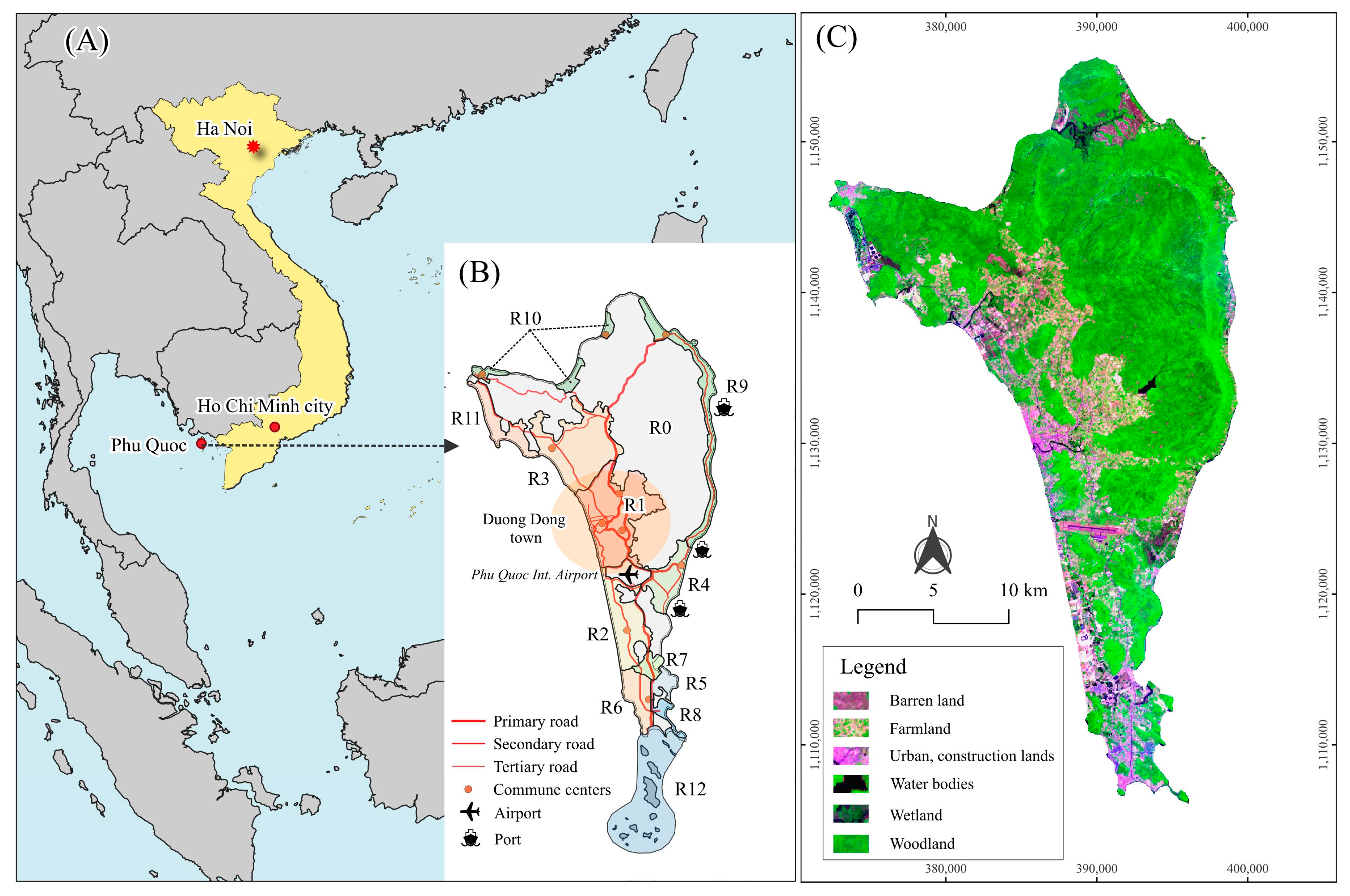
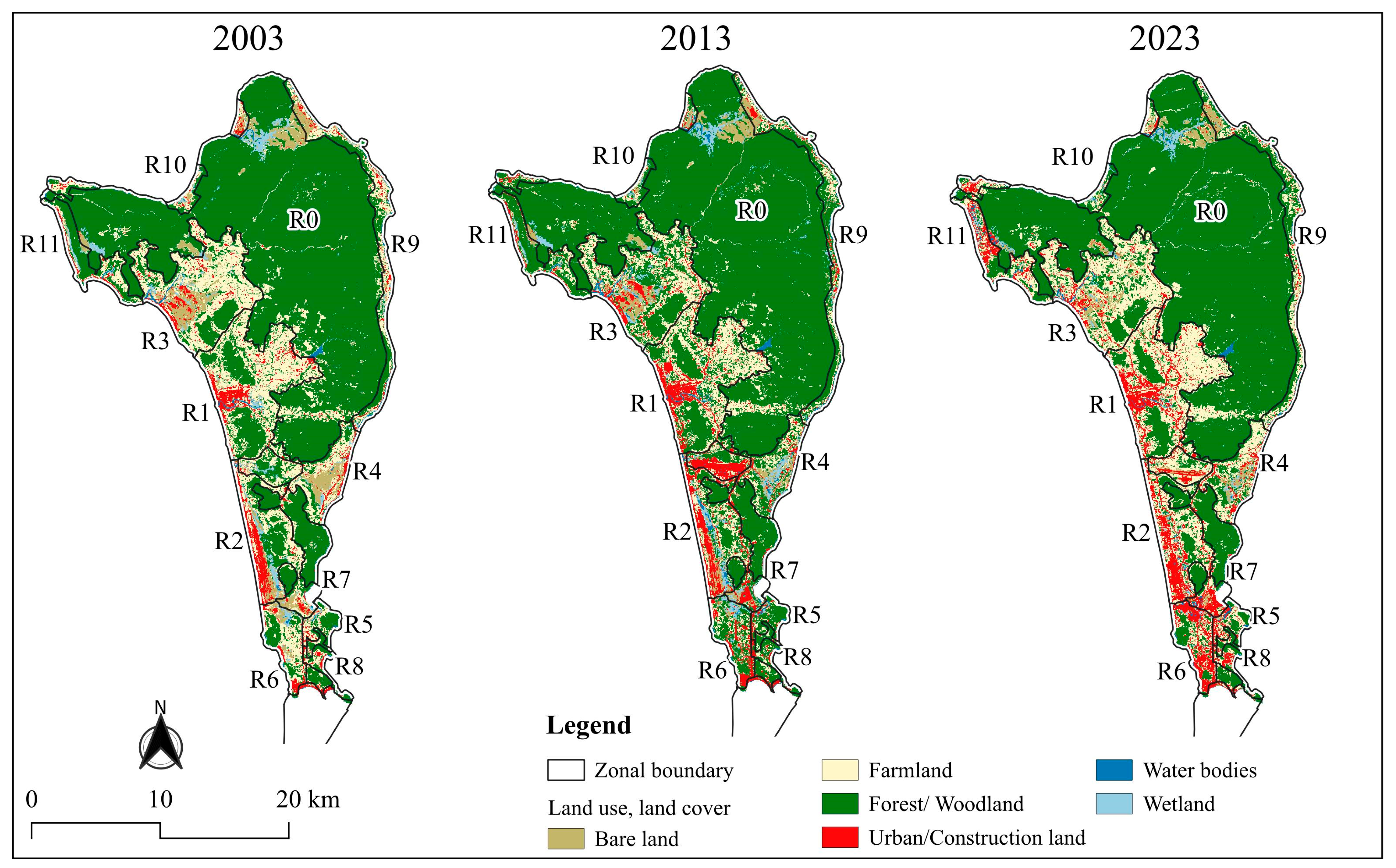
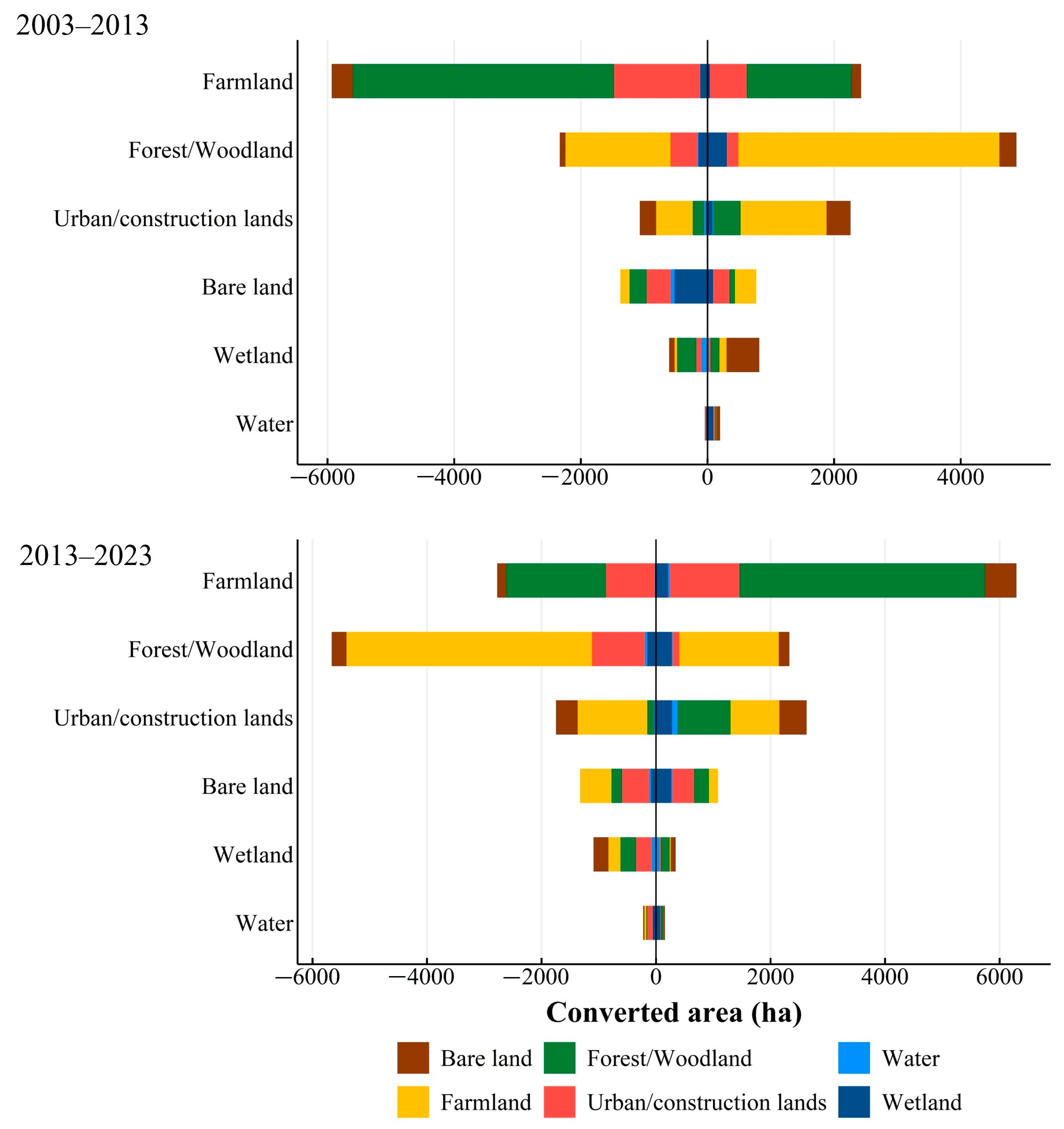
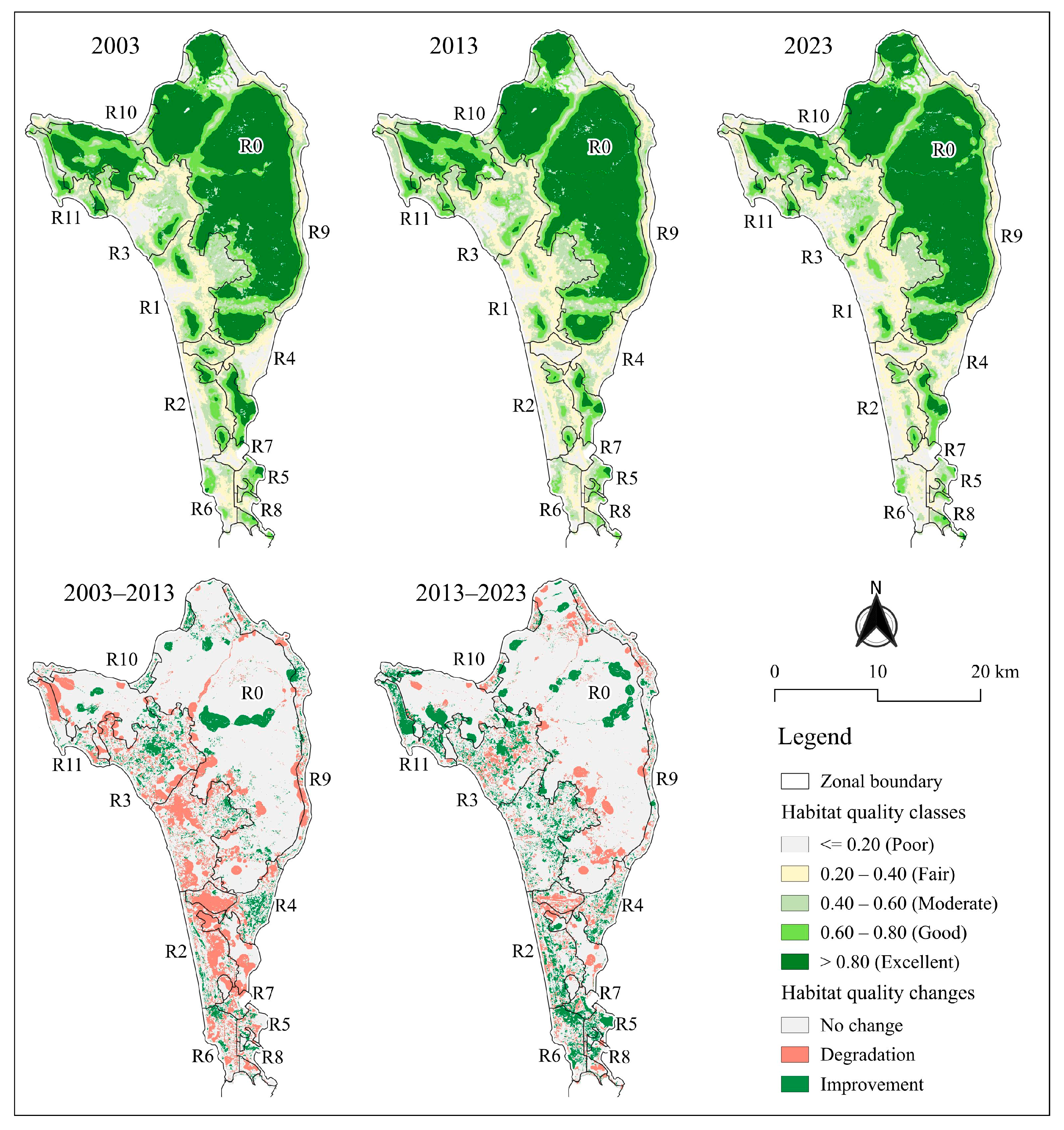
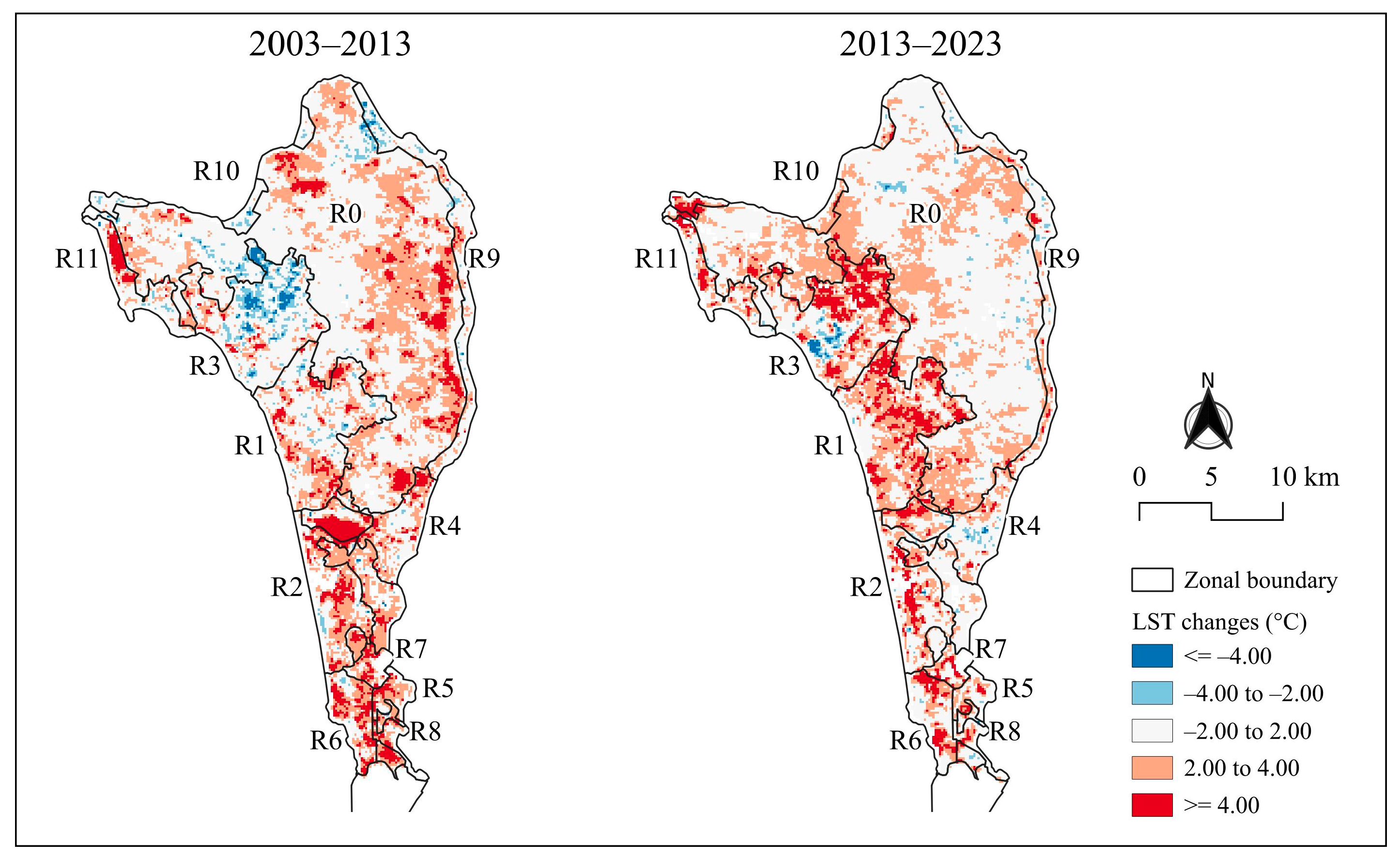
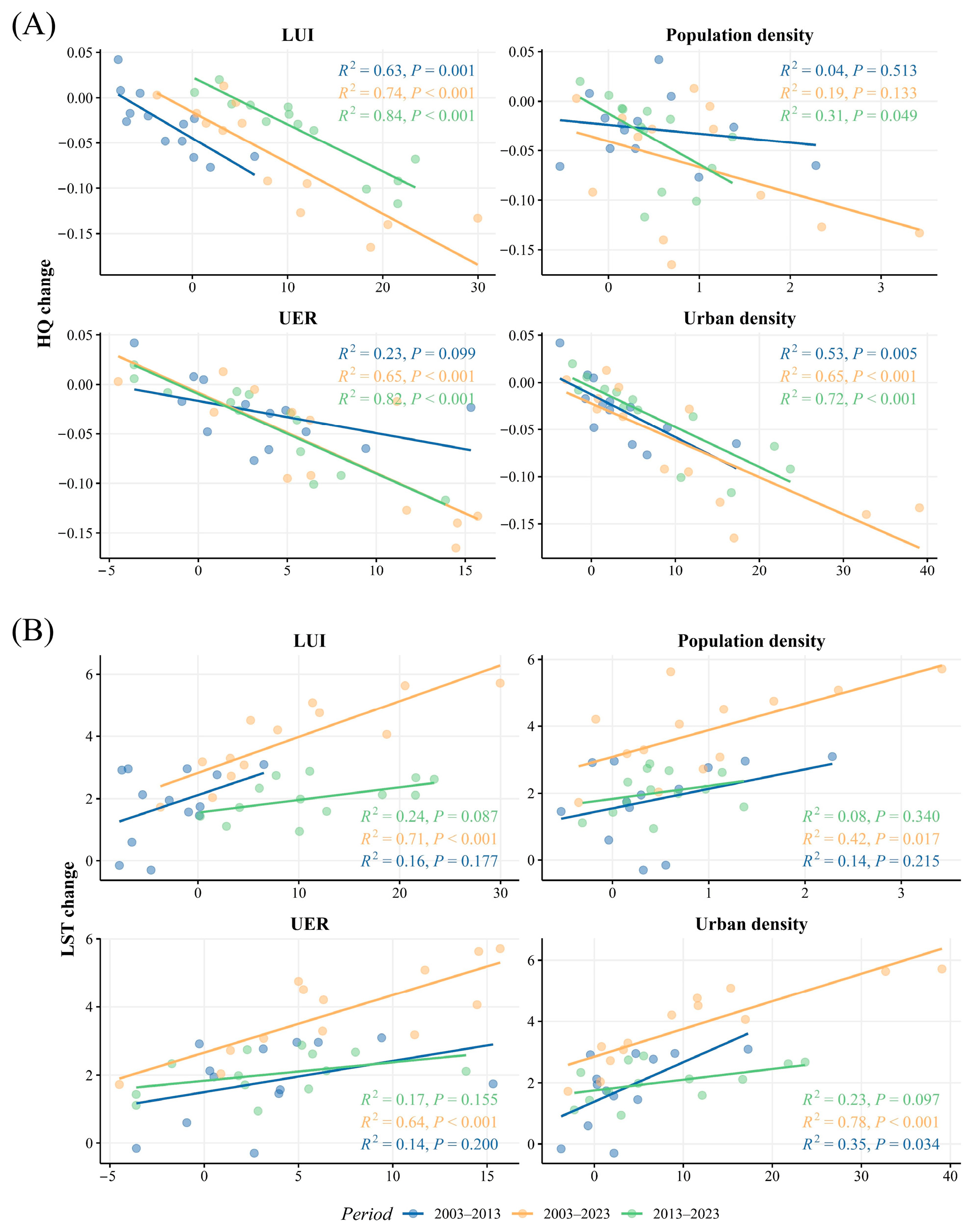

| Subdivision | Focused Area | Development Orientation |
|---|---|---|
| R0–Subdivision 0 | Remaining areas | The areas are not planned for urban and tourist development and are used for ecological conservation purposes and have minimal impact. |
| R1–Subdivision 1 | Duong Dong townlet | It is a general administrative, political, cultural, and sports centre for the island. This is also a main urban and commercial centres for mixed tourist activities. |
| R2–Subdivision 2 | Bai Truong region | One of the main integrated tourist centres that comprises shopping malls, tourist services, and entertainment. |
| R3–Subdivision 3 | Bai Ong Lang Beach—Cua Can commune | It is the northern mixed urban–tourist centre, which concentrates commercial centres, tourist services, professional education, and high-tech centres. |
| R4–Subdivision 4 | Bai Vong Beach | It is intended to be a mixed tourist service area, combining high-quality resorts with golf courses. |
| R5–Subdivision 5 | Bai Sao Beach | It is planned to be a high-class tourist area with open structures, eco-resorts, and sea sports. |
| R6–Subdivision 6 | An Thoi townlet | A mixed urban–tourist area combining seaport and residential areas, trade, tourist services, and cultural centres with typical historical values. |
| R7–Subdivision 7 | The Dam Bay | An integrated area for residential purposes and tourists. This area also supports small-scale industrial activities and seaport logistics services. |
| R8–Subdivision 8 | Bai Khem and Bai Ong Doi Beaches | Tourist service areas serving as high-class eco-resorts and sea sports. |
| R9–Subdivision 9 | Eastern coastal areas | An eastern centre of mixed urban–tourism areas, including eco-resorts, sea sports, entertainment, and golf courses. |
| R10–Subdivision 10 | Northern coastal areas | This region consists of component areas for urban–tourism purposes. It mainly includes high-class eco-resorts combined with forest sightseeing and marine conservation areas. |
| R11–Subdivision 11 | Northwest coastal areas | A mixed urban–tourist area consists of high-class resorts and resorts combined with golf courses, sea sports, and entertainment. |
| R12–Subdivision 12 | Nam An Thoi islands | It is planned for southern islets, which mainly stand on tourist services and activities in islets and marine conservation areas. |
| LULC Category | Description |
|---|---|
| Bare soil | Refers to exposed soil (loam soil) without or with less vegetation cover during observation time due to natural processes or human activities, such as idle agricultural land, sparse grassland, and deforested lands. |
| Farmland | Agricultural land is located in flat plains, where annual crops such as rice, beans, peanuts, vegetables, pepper plantations, and other annual crops are cultivated. |
| Forest/Woodland | It describes overgrowth and dense tree landscapes, which embrace natural forests, plantations, perennial plants, green spaces, and orchards. |
| Urban and construction lands | Land is occupied by dense human settlements in cities and towns with intensive domination of impervious surfaces and high-reflectance materials, such as buildings, houses, roads, and utilities. It also includes construction land, which is specifically allocated for construction and urban/infrastructure development projects. This land is typically barren due to the land levelling process using sand (especially in coastal regions) before the projects are initiated, resulting in high reflectivity and surface temperature. |
| Water bodies | Natural and artificial water surfaces are used for water transport, irrigation, and domestic consumption, such as ponds, lakes, rivers, and canals. |
| Wetland | It describes a transitional ecosystem between terrestrial and aquatic environments, where there is the presence of both vegetation and water, either permanently or seasonally. The primary wetland landscapes in Phu Quoc include mangroves in estuaries, melaleuca swamps, and man-made floodplains. |
| Threat Source | Maximum Distance (km) | Threat Weight | Decay Function |
|---|---|---|---|
| Major roads (ROAD) | 1.0 | 1.0 | Linear |
| Urban/construction lands (URBN) | 3.0 | 1.0 | Exponential |
| Farmland (FARM) | 1.2 | 0.7 | Linear |
| Bare soil (BAR) | 1.0 | 0.5 | Exponential |
| Habitat | Habitat Suitability | Threat Sources | |||
|---|---|---|---|---|---|
| ROAD | URBAN | FARM | BAR | ||
| Water bodies (WAT) | 0.8 | 0.6 | 0.8 | 0.7 | 0.3 |
| Wetland (WET) | 0.9 | 0.7 | 0.9 | 0.7 | 0.4 |
| Bare soil (BAR) | 0.2 | 0.1 | 0.2 | 0 | 0 |
| Urban/construction lands (URBN) | 0 | 0 | 0 | 0 | 0 |
| Forest/Woodland (FOR) | 1 | 0.8 | 0.9 | 0.6 | 0.5 |
| Farmland (FARM) | 0.6 | 0.8 | 0.9 | 0 | 0.5 |
Disclaimer/Publisher’s Note: The statements, opinions and data contained in all publications are solely those of the individual author(s) and contributor(s) and not of MDPI and/or the editor(s). MDPI and/or the editor(s) disclaim responsibility for any injury to people or property resulting from any ideas, methods, instructions or products referred to in the content. |
© 2025 by the authors. Licensee MDPI, Basel, Switzerland. This article is an open access article distributed under the terms and conditions of the Creative Commons Attribution (CC BY) license (https://creativecommons.org/licenses/by/4.0/).
Share and Cite
Nguyen, C.T.; Downes, N.K.; Sitthi, A.; Losiri, C. Tourism-Induced Land Use Transformations, Urbanisation, and Habitat Degradation in the Phu Quoc Special Economic Zone. Urban Sci. 2025, 9, 11. https://doi.org/10.3390/urbansci9010011
Nguyen CT, Downes NK, Sitthi A, Losiri C. Tourism-Induced Land Use Transformations, Urbanisation, and Habitat Degradation in the Phu Quoc Special Economic Zone. Urban Science. 2025; 9(1):11. https://doi.org/10.3390/urbansci9010011
Chicago/Turabian StyleNguyen, Can Trong, Nigel K. Downes, Asamaporn Sitthi, and Chudech Losiri. 2025. "Tourism-Induced Land Use Transformations, Urbanisation, and Habitat Degradation in the Phu Quoc Special Economic Zone" Urban Science 9, no. 1: 11. https://doi.org/10.3390/urbansci9010011
APA StyleNguyen, C. T., Downes, N. K., Sitthi, A., & Losiri, C. (2025). Tourism-Induced Land Use Transformations, Urbanisation, and Habitat Degradation in the Phu Quoc Special Economic Zone. Urban Science, 9(1), 11. https://doi.org/10.3390/urbansci9010011








